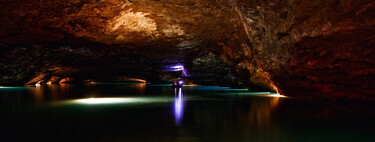When we talk about water reserves, our eyes usually immediately go to the reservoirs. This is normal because they are the most visible resource: they are there and there are mechanisms to measure their health in real time. However, a vital source is groundwater. In Spain, for example, two out of ten Spaniards have water thanks to aquifers and the occurrence of cases like that of Doñana is dramatic.
Water from aquifers is not limited to human consumption, but also to agriculture. With well-regulated use, there will be no shortage problems, but climate change and indiscriminate use through illegal wells are destroying a third of the world’s aquifers.
Italy also depends on these groundwaters and a few months ago an underground oasis was discovered: a lagoon with 17.3 cubic kilometers of water sweet. It was in the southern area of Sicily and the discoverers They affirm which is something that can be repeated in other coastal regions of the Mediterranean.
A large underground pool
Within the great European diversity, Sicily is a very interesting case. It is the largest island in the Mediterranean and, due to its location, has been a key point for the production of fruits such as oranges, lemons and mandarins, but also vegetables, legumes and, of course, the cultivation of vines for the production of wine.
However, average temperatures are increasingly higher and, as recognize One of the Sicilian farmers: “We used to grow lemons and olives, but the soil and climate have changed. Now we grow mangoes, avocados and papayas“. This increase in temperatures is such that some people are even considering planting coffee commercially.
This new plantation needs water (in Spain there are also fruits such as avocados that, in fact, have already caused some schisms by being illegally watered in the middle of a drought) and discoveries such as that of this enormous underground pool can be a good relief. It was found in the south-east of Sicily and its discoverers claim that it has 17.3 cubic kilometres of water in an aquifer between 800 and 2,100 metres deep.
They did not find it by chance, as the team approached the investigation by having studied a large set of data from oil and gas wells in the area and, to carry out the study, They used 3D geological and hydrogeological modelsUsing these models (an analysis of 121 deep well logs), they have reconstructed the regional stratigraphic geometry of the study area.


Water salinity levels
The bottom line is that it’s a huge amount of fresh water that could be a great help for the region’s consumption and use, and a good question is how did it get there. Researchers have a hypothesis that points to something called ‘Messinian salt crisis‘This occurred towards the end of the period of the same name, some 5.3 million years ago.
There was a massive accumulation of salt at the bottom of the Mediterranean Sea because it was isolated from the Atlantic due to the closure of the Strait of Gibraltar. This salt concentration affected the water levels in the sea and meteoric water (that which falls in the form of rain, snow or hail, among other states) would filter into large pockets.
Hundreds of thousands of years later, plate movement ‘reopened’ the strait and the Mediterranean refilled, but the rainwater collected by then would have already formed the aquifer beneath present-day Sicily.
The study concludes by stating that such a large and well-preserved water reserve can be effectively used on Mediterranean coasts that lack this resource, such as Morocco, Tunisia, Egypt, Lebanon or Turkey. In addition, they state that we currently have tools to exploit aquifers at that depth and it is not ruled out that in the Mediterranean basin there may be aquifers similar to those discovered in Sicily.
Images | Nature, Bluemangoa2z
At Xataka | 50 kilometers of underwater volcanoes under the Antarctic ice. The new discovery of an Italian expedition











![[Img #73861]](https://thelatestnews.world/wp-content/uploads/2024/09/Dark-matter-near-Mars-300x200.jpg)
Add Comment